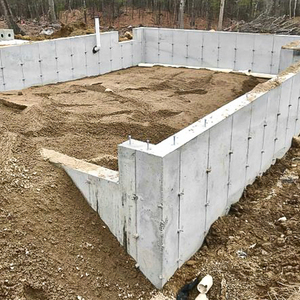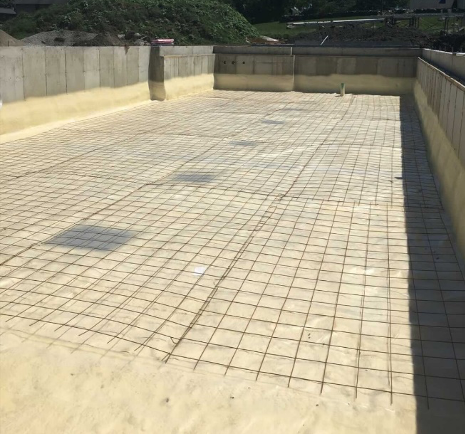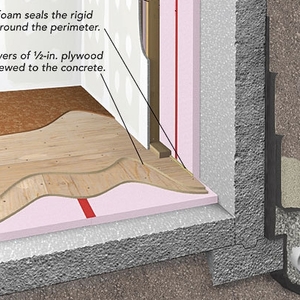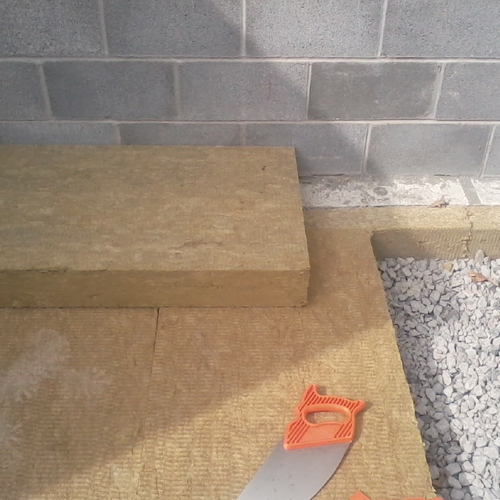
When, if ever, should you consider installing a continuous layer of rigid foam under a concrete slab?
The answer to this question depends on at least four factors: (1) your climate zone, (2) the height of the slab with respect to grade, (3) whether the room above the slab is used for living space; and (4) whether the slab has hydronic heat.
The most common insulation materials for use under a concrete slab are extruded polystyrene (XPS) and expanded polystyrene (EPS). Of these two materials, green builders prefer EPS, because EPS is manufactured with a more environmentally benign blowing agent than XPS. (For more information on this issue, see “Choosing Rigid Foam.”)
If you prefer to avoid the use of rigid foam insulation, you might want to consider installing mineral wool insulation under your slab. For more information on this approach, see “Sub-Slab Mineral Wool.”
Code requirements
Insulation requirements for slab-on-grade floors can be found in section R402.2.9 of the 2012 IECC and 2015 IECC, as well as section N1102.2.9 of the 2012 IRC and 2015 IRC. Code requirements for slab insulation are very poorly written; in fact, they are almost unintelligible. Here’s my translation:
Weekly Newsletter
Get building science and energy efficiency advice, plus special offers, in your inbox.

This article is only available to GBA Prime Members
Sign up for a free trial and get instant access to this article as well as GBA’s complete library of premium articles and construction details.
Start Free TrialAlready a member? Log in















42 Comments
And don't forget to use reclaimed foam.
and don't forget to understand its almost impossible to find in most places, and takes some work to find out exactly what it is.
It's easy to find in New England. It's usually just dirty, but otherwise fine. Try Craigslist.
Insulation depot or Green insulation group - both in MA
In Zone 6, R-10 sub slab insulation greatly increases the comfort level. I finished a town house in 2010 and we debated adding a gas boiler and Pex tubing for the lower level. This would have been in addition to a high efficiency gas furnace with AC. The cost of the extra system was too high so we opted to zone the lower level (forced air) and put R-10 under the basement slab. This was done at a cost of about 1/3 that of adding the gas boiler. The temperature between levels is very uniform during the heating season but the difference is quite noticeable when visiting another unit in the development without the sub slab insulation.
i'm going for r7.5 and using wood runners to prevent "cracking" while placing concrete. I don't think the wheelbarrows go over R10 any easier. lol. I got 7.5 for $7/ sheet discount on a sale at Menards. Thanks for the timely article.
I know there are very specific requirements for the density of foam beneath footings, but what about for a basement slab?
Appleguy, 15 psi foam--that is, foam tested to deform no more than 10% of its thickness under a 15 psi load, is strong enough for use under most slabs. Sometimes 25 psi foam is more appropriate; it depends on the situation.
What compressive strength foam is recommended under a residential garage floor, holding passenger car and light pickup truck?
https://www.constructionspecifier.com/out-of-sight-not-out-of-mind-specifying-thermal-insulation-below-grade-and-under-slab/
And don't forget to meet local code requirements, which my be higher than the recommended R-values provided here
Steve,
I explained the requirements in the IRC and IECC, and I'm not aware of any local code requirements (at least in the U.S.) that exceed my recommendations. Can you specify what location might have higher minimum requirements?
In case others are finding this article, the 2018 BC Building Code (Canada) specifies sub-slab insulation for all but "unheated floors" below the frost line. From my reading of the code (9.36.2.8) it is required if a basement slab is above the frost line, for slab-on-grade, or if the slab is heated. Zones 4 to 8 are listed (in metric RSI, of course).
https://www.bcpublications.ca/BCPublications/
(As always, thank-you Martin for an excellent article and pardon my comment over a year late.)
Is there any data on center of house average winter time soil, (or crushed rock or gravel), temperature just below the slab? Many variables here, but with good data it should not be too hard to figure out the desired insulation.
Thomas,
This is a contentious topic. See my Comment #16 and my Comment #23 on this page: "Can Foam Insulation Be Too Thick?"
Before delving into these comments, I'd like to make a point: while it is possible to vary the thickness of horizontal sub-slab foam, with the thicker foam near the perimeter and thinner foam at the center of the slab, this is not a builder-friendly method that makes any sense on a job site. In most cases, builders prefer to install the same thickness of rigid foam under the entire slab, rather than to install a thinner area of foam in the center of the slab.
In Comment #16, I wrote, "According to John Straube's e-mail to me, he based his calculation on measured data. Here's what he wrote: 'The prediction of heat loss through slabs is notoriously inaccurate. I recently did a literature survey of measured temperatures and heat loss of slabs and basements, looking for real measurements of insulated cases. As an example of one of the few results I found, a slab on grade insulated to R-32 in Finland had an average heating seasons soil temperature of 12.5 C (55 F).'"
My Comment #23 quotes John Straube at length. John Straube wrote, ""Mr Semmelhack's question points to the root of the confusion: the lack of good models because of a lack of measured field data. I agree that PHPP gives too low a temperature, and that the 'average annual ground temperature = average annual ambient air temperature' also misses the target (mostly because it ignores the fact that there is a heat source above the soil — the house — providing heat for 12 months of every year). This is the reason that I was basing my numbers on measured data, even though it is sparse.
"The closest example I have is the Finnish paper 'Thermal and Moisture Conditions of Coarse-grained Fill Layer Under a Slab-on-ground Structure in Cold Climate' from the Journal of Thermal Envelopes and Building Science, Vol 28, no. 1, July 2004. The coldest temperature measured was 45°F, rising to 68°F by the end of the summer, before falling again.
"A more recent paper, 'Heat, Air, and Moisture Control in Slab-on-ground Structures,' Journal of Building Physics, Vol. 32, No. 4, April 2009, shows even higher temperatures, with averages of 15°C/60°F in the winter, except near the edge where they dropped to 10°C/50°F (winter average over 15°C though).
"In Norway, another cold climate that builds lots of slab on grade, a paper in the 7th Nordic Building Physics Conference on slab heat loss reported, 'In Norwegian climatic conditions, with a yearly mean soil temperature varying from 2° ~ 7°C, we can use 12°±1°C as a default value for the inner zone reference soil temperature". 12°C is 53.6° Fahrenheit.
"In Britain, a study of a commercial building is reported in 'Temperatures in and under a slab-on-ground: two- and three-dimensional numerical simulations and comparison with experimental data,' in the journal Building and Environment, Vol. 35, 2000, found temperatures (in a milder climate near Cardiff, Wales) in the 14°-16°C (57°-61°F) range during winter periods. I also have some papers from Sweden, and basement measurements from Canada.
"Suffice it to say, if I base my design on real measured results, rather than someone's model, I repeatedly find that the temperatures of the sub slab range from the 10°C to 15°C range (50° to 60°F).
"I would be interested in hearing about any published measured data to add to my small but growing collection."
How about on a FPSF in Zone 6?
Trevor,
My recommendation in the article for a slab on grade in Climate Zone 6 is to include at least R-10 horizontal insulation under the slab. That's more than enough to meet the requirements for a frost-protected shallow foundation.
Of course, a frost-protected shallow foundation also requires either vertical insulation at the slab perimeter, or "wing" insulation, or both.
For more information on frost-protected shallow foundations, see these resources:
"Frost-Protected Shallow Foundations"
"Revised Builder’s Guide to Frost Protected Shallow Foundations"
If I put eight inches of EPS under a raft slab in Zone 7 how thick and how wide should the skirt be? Also, does it have to be 12 inches underground? Also should it be flush with the top of the sub-slab foam or the bottom (assuming it is les than eight inches).
Nils,
I think you are confusing raft slabs with frost-protected shallow foundations.
By "skirt," I assume you mean horizontal insulation that extends out from the perimeter of the building footprint, to protect the soil near the perimeter of the building.
Most frost-protected shallow foundations have an insulation skirt. Most raft slabs do not.
For more information on frost-protected shallow foundations, see "Design Guide for Frost-Protected Shallow Foundations."
For more information on raft slabs, see "Foam Under Footings." At the top of the page, there is a green rectangle with the words, "View Gallery." Click this green rectangle to see a series of 10 images, including many images of raft slabs. You'll see that the vast majority of raft slabs have no skirt insulation.
For an example of a typical raft slab foundation, see the first image attached below.
All of that said, one of the home's discussed in "Foam Under Footings " -- namely Chris and Zoe Pike's house in Ripton, Vermont, which was designed by Chris Corson -- has a raft slab that includes skirt insulation. That unusual detail is shown in the second image posted below.
I believe I do mean a raft slab. But the whys and wherefors of the the difference between an eight inch thick cement slab over the entire floor and a 4 inch slab thickened at the edges to produce a grade beam the size of normal footings, escape me. Is the double reinforcing and 8 inch thickness of the former intended to prevent cracking of the cement should the ground subside? Also I would guess that heating that much concrete where 20 to 30 degree temperature swings in one day are commonplace would be difficult to regulate. I don't see any pipes in the drawing, but then again the rebar and wire mesh doesn't show either. Mostly I'd like to know why «most raft slabs do not.» have an insulation skirt. (Sorry, I can't find the quotation marks on this french keyboard)
Nils,
Frost-protected shallow foundations (FPSFs) follow certain guidelines which are accepted by most North American building codes. Raft slabs (as far as I know) fall outside of prescriptive codes and must be individually engineered and approved.
As you noted, raft slabs are usually structural -- allowing point loads at almost any part of the slab. In contrast, FPSFs have thinner (usually 4-inch-thick) slabs that are non-structural.
If you need specific questions answered for your design, including rebar specifications, you'll need to talk to an engineer.
I may have drawn the CAD detail above when I worked at Ecocor. If not, I drew similar details many times. There are a few reasons to include a frost wing:
1. The basic rules for designing a frost protected shallow foundation can be found in the IRC. They are based on the recommendations in ASCE 32-01. Both sources assume some heat loss from the interior space to help keep the ground warm under the building. In the middle of the house, the earth's heat will easily keep the ground from freezing. But when you get near the perimeter, the earth's heat is fighting against cold air that wants to freeze the ground. Prescriptive code where I am says a frost protected shallow foundation only needs vertical insulation 12" below grade. When the sub-slab foam is thin, that may be enough, but with 8-12" of foam you are getting essentially zero help from the conditioned space. If you look at the guidelines for frost protected slabs for UNconditioned spaces, you will see that in cold climates you need wide frost wings, and it's safe to think of highly insulated raft slabs along the same lines.
2. In any slab system in a cold climate, ground water is an enemy--if the ground below the slab is wet, it can freeze and expand. If the ground is dry, even if it got very cold, with no water it can't expand. The frost wings push water 3' away from the building, and a well-graded site takes care of water from there.
The raft slab system meets the requirements in the IRC as long as the top of the frost wing, if less than 12" below grade, is protected with a concrete topping (or similar). Most builders skip this step--it's not a life safety issue, and the frost wing isn't even required in most cases. ("Required" being different than "good insurance.")
Michael,
Thanks for your detailed and helpful response.
Years ago 1994 I put 1" of Blue board under a slab on grade shop floor and none in the next room same building the floor temp Difference was Notice able almost year round with bare feet or stocking feet I always regretted the lack of foam under that floor,
Scott
Out of curiosity I just measured floor temperatures. The shop with slab on grade heated to 10C to 15C was 11C-12C. The ten year old addition to the house (slab on grade with two inches of styrofoam) was 9C-10C. The opposite of what I expected. It makes me wonder what the trade off between more thermal mass and more insulation under the thermal mass is. In the seventies solar and thermal mass were all the rage. I think we are heating our houses to much higher temperatures than the back to the landers of the day. Despite only average insulation in the shop with no insulation under the slab, it stays above freezing for several days of minus 20C with no heating. (ran out of propane between Christmas and new year last year)
Hi, our concrete slab is broken in places, and we need to decide whether to patch it or to remove it and re-lay it. It is currently uninsulated. We are in zone 9 in the UK, what are your thoughts on whether there is any need to have horizontal insulation under a slab in zone 9? This particular stone house is built directly onto the bedrock in some places. Many thanks for your useful articles.
Alder,
I'm unfamiliar with climate zones in the U.K. It would probably be more helpful if you could be specific -- for example, tell us the name of the town where you live, or tell us the typical minimum winter temperature at your home's location.
Hi Martin, I'm in Cardiff, where the research about ground temps that you linked to above was carried out. Average coldest temps in February are 2C. We have mild winters with occasional snows and frosts.
Alder,
Your climate sounds mild -- perhaps similar to Atlanta, Georgia. That's in Climate Zone 3.
If you follow the recommendations in this article for Zone 3, you'll be fine.
Martin, which climate/zone model are you using?
Alder,
The climate zone map developed by the U.S. Department of Energy. Here is a link to the map.
In your chart you list that Zone 3 does not require insulation for basement slab. If you lived at the edge of Zone 3 & 4 in Alabama, what would you recommend or do if it was your house?
I too welcome a reply to Colby’s question: what would you recommend for a basement slab in Climate 3 if it were your house?
Due to termites in GA & AL, the insulation will be above the slab.
Mark,
I stand by the recommendations in my article. In Climate Zone 3, a basement slab with no hydronic tubing does not require horizontal insulation.
This is good info for climate zones 1-8, but my house is in climate zone 16.
NIcholas, considering the sub-arctic is zone 8, I don't think you're in zone 16. Check out the second map on this page: https://www.greenbuildingadvisor.com/article/all-about-climate-zones. If you're in another country you'll have to go by the heating degree days in the chart below that.
US DOE climate zones are not the same as CA Title 24 climate zones or USDA plant hardiness climate zones. DOE climate zones 1-8 include everything from southern Florida or Hawaii to the north slope of Alaska, and everything in between.
Thanks. It wouldnt be CA if we didnt have our own zone numbers.
>"It wouldnt be CA if we didnt have our own zone numbers."
Did CA ever assign a number to the Twilight Zone? :-)
When you recommend none for a crawlspace, do you distinguish between a conditioned and an unconditioned crawl? Ours in CZ 6B will be fully conditioned to within degrees of house temperature, and will have a rat slab. We are planning R20 EPS, but are starting foundation now and I'm wondering if it's overkill. I care more about air quality than energy efficiency. The foundation is be 3-4' deep ICF block.
Qofmiwok,
Adding EPS insulation under your rat slab (in a conditioned crawlspace) is probably overkill, and is probably hard to justify in terms of anticipated energy savings. That said, if you can afford it, bravo. You'll have a very well-insulated crawlspace.
Martin (or other experts),
I’m building a house in Salina, KS (zone 4). I’m thinking of putting insulation under the basement slab, not so much for energy savings, but for other reasons you mentioned in your article “Determining Sub-Slab Rigid Foam Thickness.” Our weather gets very humid in the summer and I am concerned about condensation on a cool floor. I should mention the house will be a 6” SIP house with an ERV and a walkout basement. I have a few questions …
1. Do you think I should go ahead and do the horizontal slab insulation?
2. And if so, do you still stand by the R5 being sufficient? The R5 is much cheaper than R10, but comes with a lower PSI of 15, too. Some say to only use a product with a PSI of 25 under the slab.
3. Finally, if you do recommend the horizontal insulation, does taping the seams matter if I am putting poly over the top? I’m not too concerned about soil gases, as the house will already have a passive radon pipe and the ERV will be exchanging air regularly.
Thanks.
Log in or become a member to post a comment.
Sign up Log in